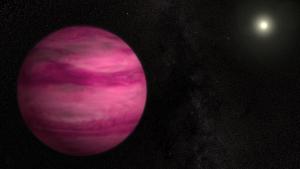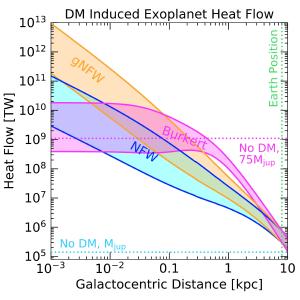Blog
Warming Up to Dark Matter
5 May 2021
 NASA/Goddard Space Flight Center/S. Wiessinger
NASA/Goddard Space Flight Center/S. WiessingerAh, dark matter, you continue to elude us. The stuff is incredibly difficult to study. It doesn’t interact with light, so our evidence of it is based upon its gravitational effects on light and visible matter. And the biggest difficulty is that we still don’t know what it is. Efforts to detect dark matter directly have come up empty, as have indirect methods such as looking for evidence of dark matter through things such as excess gamma-rays in the Milky Way. But astronomers continue to think up new ways to detect the stuff, such as a recent study published in Physical Review Letters.1
This new study takes an interesting approach. One of the popular ideas for dark matter is that it’s composed of Weakly Interacting Massive Particles (WIMPs). These particles would be more massive than known particles such as electrons or protons. Through the weak nuclear force, dark matter particles should decay into lighter particles. While the decay particles could be difficult to observe directly, the study proposes looking for their effect on exoplanets.
Since dark matter and regular matter interact gravitationally, exoplanets could capture a bit of dark matter, which would tend to cluster around their cores. As the dark matter decays, it would release heat energy into the exoplanet, thus making it warmer than it otherwise would be. So, if we find that exoplanets are typically a bit warmer than expected, this would be evidence of dark matter.
 Leane and Smirnov
Leane and SmirnovA good candidate for this kind of study would be large exoplanets, such as super-Jupiters. Their high mass would tend to capture plenty of dark matter, and their expected temperatures are well understood. Since super-Jupiters are made mostly of hydrogen and helium, the majority of their core heating comes from gravitational contraction. Just as squeezing a rubber ball makes it warmer, super-Jupiters are heated by the squeezing of gravity. These planets aren’t large enough to trigger nuclear fusion like stars, so if they are warmer than we expect, it must be through some kind of radioactive decay.
Through their dark matter heating model, the team showed that the effect should be detectable by next-generation telescopes such as the James Webb Space Telescope. Since the amount of excess heating would depend upon the amount of dark matter in the Milky Way, the technique could also be used to map the distribution of dark matter in our galaxy. We could then start narrowing down our dark matter models.
It’s possible that when the JWST comes online, a survey of exoplanets will find no warming. But even that would be a good result. It would confirm that dark matter doesn’t warm exoplanets, so either it doesn’t exist, or it’s something even more strange than we thought. The only way to solve the dark matter mystery is to keep gathering data.
Leane, Rebecca K., and Juri Smirnov. “Exoplanets as Sub-GeV Dark Matter Detectors.” Physical Review Letters 126.16 (2021): 161101. ↩︎